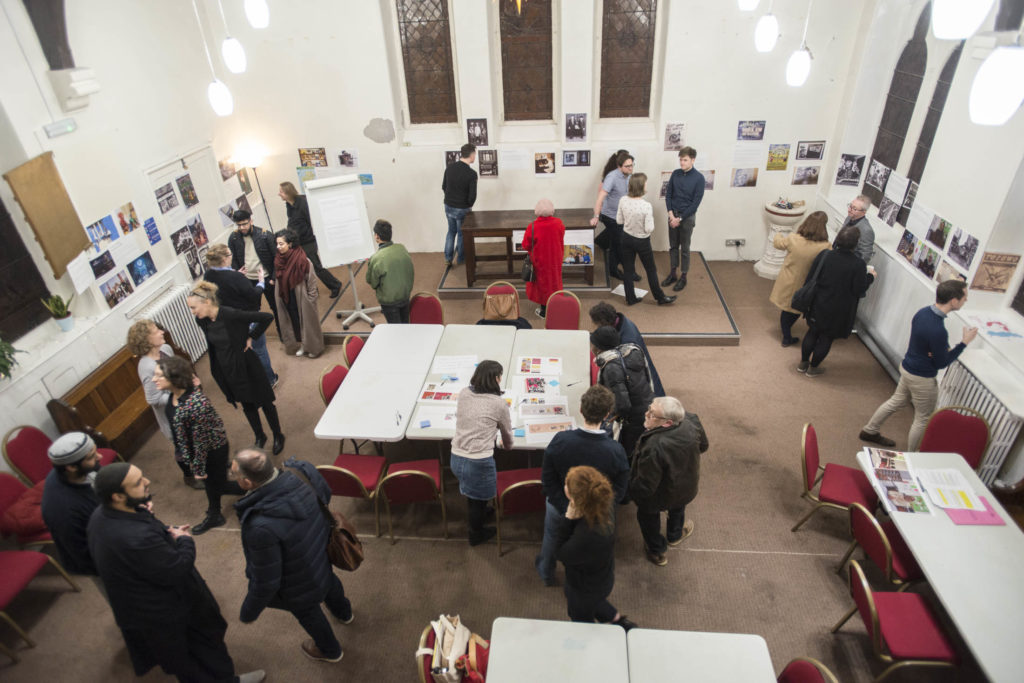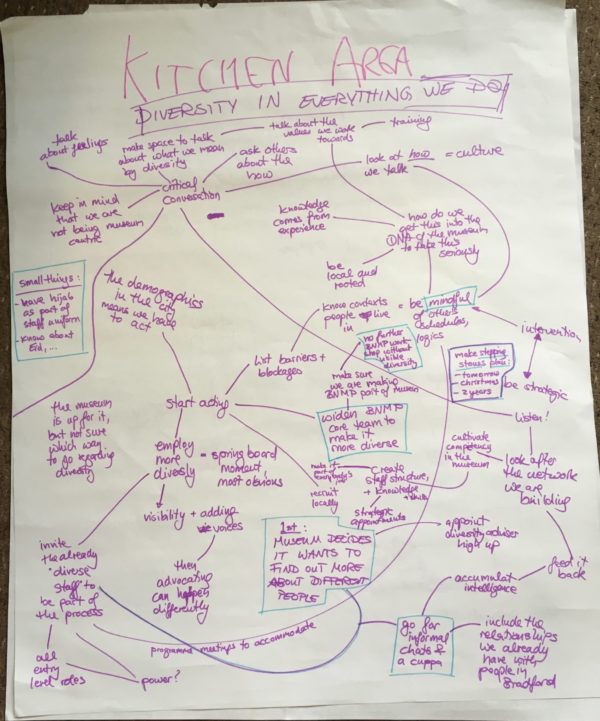Above the Noise Reflective Process
After the launch of Above the Noise: 15 Stories from Bradford we reflected on the process with visitors, staff and collaborators. The differences in how people experienced the Above the Noise was striking. As part of the process of reflection we developed ways for people to see the issues from other people’s perspectives. This ‘whole system’ approach to reflection led to new research questions which focused our attention on key tensions.
The aim was to use the process of developing Above the Noise: 15 Stories From Bradford to understand how the museum might work collaboratively at scale and how the collections and themes of the museum might become connected to issues that matter to people who live and work in Bradford.
Following the launch of the exhibition, we wanted to use a process of reflecting on the experience of being part of Above the Noise to sharpen up our understanding of the issues and to plan the final phase of the research project. We carried out the reflective process in a variety of ways, through research with visitors in the gallery, through discussions with the visitor experience staff who spent time in the gallery and interviews and workshops with those – both staff and Bradford collaborators – directly involved in delivering the exhibition. As action research the Above the Noise reflective process was not conceived as summative but as a live and active process that would use our experiences to clarify and shape our research questions and to move the project on.

Braford’s National Museum project gathering at the Delius Centre to discuss the planning and content of the Above the Noise exhibition at the National Science and Media Museum. Image credit: Tim Smith
The process revealed that different people saw and understood the experience of Above the Noise in quite different ways, depending on their position within the process.
Visitors really enjoyed it and spent time in the gallery chatting with the visitor experience staff. However, many didn’t understand the key messages and understood the exhibition to be more about celebrating diversity in Bradford than the use of technology to navigate the impact of negative representations of Bradford in the national media. Collaborators were glad to be involved but frustrated with how inflexible and unresponsive the museum seemed to be and with the way control seemed to be passed over to the museum by the end of the process. Staff felt rushed, under pressure and exhausted by having to navigate the institution and the new collaborative relationships.
While the diverging nature of the perspectives was unsurprising in many ways, it became clear that it was essential for people to have a chance to understand different people’s perspectives in order to move forward the Bradford’s National Museum’s research.

Museum staff reflect on what they’d like to see developed at the museum, prompted by the experience of making Above the Noise: 15 Stories from Bradford. Image credit: Helen Graham
We did this through a workshop held at a Bradford café called Bread + Roses. At the event we worked in four small groups, each including a mix of National Science and Media Museum staff and collaborators who were involved in different ways. Each group worked through short quotes from different people to show differences of perspective and to draw out what these diverse views might mean.
From the Bread + Roses workshop it became clear that it is relatively simple to think about any of the different issues that arose from Above the Noise singly. It is not hard to think about sound and vision technology or Bradford. It is not hard for museum staff to think about quality or being responsive to new ideas and new collaborations. Yet to really address underlying issues we need to hold together different issues, a shift from either/or thinking to both + and. The five cross-cutting questions that emerged from the workshop were:
- How can we work with the specific strengths of the museum and of the existing networks in Bradford?
- What opportunities arise from telling stories of Bradford and of different communities and questions of the science and technology of sound and vision?
- How can ideas of quality that already exist in NSMM be openly talked about and how might ideas of quality be co-produced with Bradford communities?
- How can the NSMM both be part of Science Museum Group decision-making structures and develop collaborative decision-making with people in Bradford?
- How can the NSMM prioritise the wellbeing of staff and collaborators and be responsive, brave and take risks?
These questions were used to drive the final year of the research. They were taken up and reworked by the Staff Action Research Group who linked their own everyday practice with the wider agendas of the Bradford’s National Museum project. In the desire to hold in tension seemingly conflicting aspects of the museum work, the cross-cutting questions prefigured the Tensions as Strengths approach set out in Part 3: Future Directions.
We were more than a little lost after Above the Noise: 15 Stories from Bradford. Although in some ways Above the Noise has been considered a success from a distance. Internally Above the Noise became regularly deployed as a cautionary tale of what should not happen and remembered as kind of a trauma for which the Bradford’s National research team were definitely held responsible.
I remember feeling very stuck about how to move things on. It was clear that as all of us had been so involved and were so implicated in Above the Noise, none of the research team would be able to act as facilitators for the reflective process. Julia, Lynn and I needed the chance to reflect as much as everyone else who had been involved. To help move us out of the stuck place and to enable all involved in the exhibition delivery to play the same and equal role as participants in the reflective process, we worked with an external facilitator and coach – Joanne Rule – to help us. Joanne’s involvement was exactly what we needed. She was able to come in fresh and to listen carefully to the 15 or so members of staff and the research team who had been heavily involved in design and production. In the pressure of delivery there was an extent to which we’d stopped being able to hear or understand each other. We needed to be heard individually by someone independent before we could start to hear each other again.
Helen Graham, Research Facilitator



